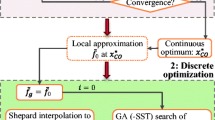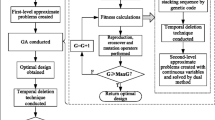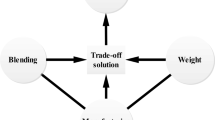Abstract
The stacking sequence optimization problem for multi-region composite structures is studied in this work by considering both blending and design constraints. Starting from an initial stacking sequence design, unnecessary plies can be removed from this initial design and layer thicknesses of necessary plies are optimally determined. The existence of each ply is represented with discrete 0/1 variables and ply thicknesses are treated as continuous variables. A first-level approximate problem is constructed with branched multipoint approximate functions to replace the primal problem. To solve this approximate problem, genetic algorithm is firstly used to optimize discrete variables, and meanwhile, a blending design scheme is proposed to generate a blended structure. Starting from the thinnest region, this scheme shares all layers of current thinnest region with its adjacent regions. For non-shared layers in the adjacent regions, local mutation is implemented to add or delete plies to make them efficient designs. The whole process is repeated until the blending rule is satisfied. After that, a second-level approximate problem is built to optimize the continuous variables of ply thicknesses for retained layers. Those procedures are repeated until the optimal solution is obtained. Numerical applications, including a two-patch panel and a corrugated central cylinder in a satellite, are conducted to demonstrate the efficacy of the optimization strategy.














Similar content being viewed by others
References
Adams DB, Watson LT, Gürdal Z (2003) Optimization and blending of composite laminates using genetic algorithms with migration. Mech Adv Mater Struct 10(3):183–203
Adams DB, Watson LT, Gürdal Z, Anderson-Cookd CM (2004) Genetic algorithm optimization and blending of composite laminates by locally reducing laminate thickness. Adv Eng Softw 35(1):35–43
Adams DB, Watson LT, Seresta O, Gürdal Z (2007) Global/local iteration for blended composite laminate panel structure optimization subproblems. Mech Adv Mater Struct 14(2):139–150
An H, Huang H (2017) Topology and sizing optimization for frame structures with a two-level approximation method. AIAA J 55(3):1044–1057
An H, Chen S, Huang H (2015a) Laminate stacking sequence optimization with strength constraints using two-level approximations and adaptive genetic algorithm. Struct Multidiscip Optim 51(4):903–918
An H, Chen S, Huang H (2015b) Improved genetic algorithm with two-level approximation method for laminate stacking sequence optimization by considering engineering requirements. Math Probl Eng 2015:1–13
An H, Chen S, Liu Y, Huang H (2016) Optimal design of the stacking sequences of a corrugated central cylinder in a satellite. Proc Inst Mech Eng Part L J Mater Des Appl published online. https://doi.org/10.1177/1464420716672097
An H, Chen S, Huang H (2018a) Concurrent optimization of stacking sequence and stiffener layout of a composite stiffened panel. Eng Optim 1–19. https://doi.org/10.1080/0305215X.2018.1492570
An H, Chen S, Huang H (2018b) Multi-objective optimization of a composite stiffened panel for hybrid design of stiffener layout and laminate stacking sequence. Struct Multidiscip Optim 57(4):1411–1426
Bruyneel M (2006) A general and effective approach for the optimal design of fiber reinforced composite structures. Compos Sci Technol 66(10):1303–1314
Chen S, Lin Z, An H, Huang H, Kong C (2013) Stacking sequence optimization with genetic algorithm using a two-level approximation. Struct Multidiscip Optim 48(4):795–805
Curry JM, Johnson ER, Starnes JH Jr (1992) Effect of dropped plies on the strength of graphite-epoxy laminates. AIAA J 30(2):449–456
Ghiasi H, Pasini D, Lessard L (2009) Optimum stacking sequence design of composite materials part I: constant stiffness design. Compos Struct 90(1):1–11
Hao P, Yuan X, Liu C, Wang B, Liu H, Li G, Niu F (2018) An integrated framework of exact modeling, isogeometric analysis and optimization for variable-stiffness composite panels. Comput Methods Appl Mech Eng 339:205–238
IJsselmuiden ST, Abdalla MM, Seresta O, Gürdal Z (2009) Multi-step blended stacking sequence design of panel assemblies with buckling constraints. Compos Part B 40(4):329–336
Irisarri FX, Abdalla MM, Gürdal Z (2011) Improved Shepard’s method for the optimization of composite structures. AIAA J 49(12):2726–2736
Irisarri FX, Lasseigne A, Leroy FH, Le Riche R (2014) Optimal design of laminated composite structures with ply drops using stacking sequence tables. Compos Struct 107:559–569
Jing Z, Fan X, Sun Q (2015) Global shared-layer blending method for stacking sequence optimization design and blending of composite structures. Compos Part B 69:181–190
Kristinsdottir BP, Zabinsky ZB, Tuttle ME, Neogid S (2001) Optimal design of large composite panels with varying loads. Compos Struct 51(1):93–102
Le Riche R, Haftka RT (1995) Improved genetic algorithm for minimum thickness composite laminate design. Compos Eng 5(2):143–161
Liang CC, Chen HW (2003) Optimum design of fiber-reinforced composite cylindrical skirts for solid rocket cases subjected to buckling and overstressing constraints. Compos Part B 34(3):273–284
Liu D, Toropov VV, Querin OM, Barton D (2011) Bilevel optimization of blended composite wing panels. J Aircr 48(1):107–118
Liu X, Cheng G, Yan J, Jiang L (2012) Singular optimum topology of skeletal structures with frequency constraints by AGGA. Struct Multidiscip Optim 45(3):451–466
Liu D, Toropov VV, Barton DC, Querin OM (2015) Weight and mechanical performance optimization of blended composite wing panels using lamination parameters. Struct Multidiscip Optim 52(3):549–562
Lopez RH, Luersen MA, Cursi ES (2009) Optimization of laminated composites considering different failure criteria. Compos Part B 40(8):731–740
Pai N, Kaw A, Weng M (2003) Optimization of laminate stacking sequence for failure load maximization using Tabu search. Compos Part B 34(4):405–413
Panesar AS, Weaver PM (2012) Optimisation of blended bistable laminates for a morphing flap. Compos Struct 94(10):3092–3105
Peeters D, Abdalla M (2016) Optimization of ply drop locations in variable-stiffness composites. AIAA J 54(5):1760–1768
Poon CY, Ruiz C, Allen CB (1994) Finite element analysis of a tapered composite. Compos Sci Technol 51(3):429–440
Rocha I, Parente E Jr, Melo AMC (2014) A hybrid shared/distributed memory parallel genetic algorithm for optimization of laminate composites. Compos Struct 107:288–297
Seresta O, Gürdal Z, Adams DB, Watson LT (2007) Optimal design of composite wing structures with blended laminates. Compos Part B 38(4):469–480
Soremekun G, Gürdal Z, Kassapoglou C, Toni D (2002) Stacking sequence blending of multiple composite laminates using genetic algorithms. Compos Struct 56(1):53–62
Todoroki A, Sekishiro M (2008) Stacking sequence optimization to maximize the buckling load of blade-stiffened panels with strength constraints using the iterative fractal branch and bound method. Compos Part B 39(5):842–850
Van Campen JMJF, Seresta O, Abdalla MM, Gürdal Z (2008) General blending definitions for stacking sequence design of composite laminate structure. In: Proceedings of 49th AIAA/ASME/ASCE/AHS/ASC structures, structural dynamics, and materials conference, Schaumburg, IL, USA, April 7–10
Venkataraman S, Haftka RT (1999) Optimization of composite panels-a review. In: Proceedings of the 14th annual technical conference of the American Society of Composites, Dayton, OH, September 27–29
Walker M, Smith RE (2003) A technique for the multiobjective optimisation of laminated composite structures using genetic algorithms and finite element analysis. Compos Struct 62(1):123–128
Yang J, Song B, Zhong X, Jin P (2016) Optimal design of blended composite laminate structures using ply drop sequence. Compos Struct 135:30–37
Zein S, Bruyneel M (2015) A bilevel integer programming method for blended composite structures. Adv Eng Softw 79:1–12
Zein S, Madhavan V, Dumas D, Ravier L, Yague I (2016) From stacking sequences to ply layouts: an algorithm to design manufacturable composite structures. Compos Struct 141:32–38
Funding
This research work is supported by the National Natural Science Foundation of China (Grant No. 11672016), which the authors gratefully acknowledge.
Author information
Authors and Affiliations
Corresponding author
Additional information
Responsible editor: YoonYoung Kim
Publisher’s Note
Springer Nature remains neutral with regard to jurisdictional claims in published maps and institutional affiliations.
Rights and permissions
About this article
Cite this article
An, H., Chen, S. & Huang, H. Stacking sequence optimization and blending design of laminated composite structures. Struct Multidisc Optim 59, 1–19 (2019). https://doi.org/10.1007/s00158-018-2158-1
Received:
Revised:
Accepted:
Published:
Issue Date:
DOI: https://doi.org/10.1007/s00158-018-2158-1




